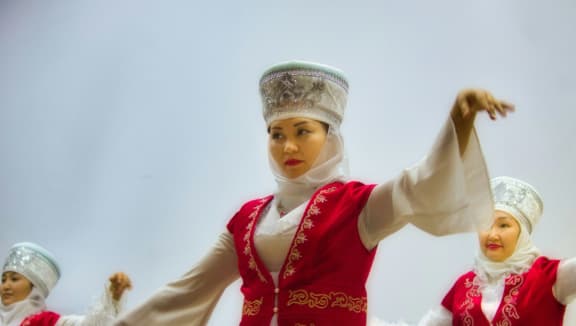The traditional dress of Kyrgyz people is more than just clothing: it’s a living expression of history, identity, and pride. Every hat, robe, and piece of embroidery tells a story about the Kyrgyz way of life, deeply connected to nature, family, and the nomadic spirit that has defined this nation for centuries. Whether you’re exploring mountain villages or local markets during your tours in Kyrgyzstan, you’ll see this elegant hat proudly worn by men of all ages.
The Famous Kalpak: Symbol of Kyrgyz Identity
No discussion about Kyrgyz traditional clothing is complete without mentioning the kalpak – the tall, white felt hat worn by men. Made from natural sheep’s wool, the kalpak is both practical and symbolic.
Its four sides represent the cardinal directions, reflecting harmony with nature and the nomadic lifestyle of the Kyrgyz people. The white color symbolizes purity, honesty, and dignity, while black embroidery adds contrast and intricate beauty. The kalpak is so important that March 5th is celebrated as National Kalpak Day in Kyrgyzstan.
Men’s Traditional Clothing: Function Meets Elegance
Historically, Kyrgyz men’s attire was designed for comfort and protection against the harsh mountain climate. The base layer, usually made of cotton or linen, was complemented by outer garments made of felt, wool, or leather.
The most common item was the chapan is a long, quilted coat worn over the shoulders. It often featured colorful patterns, embroidery, and sometimes fur trimming. Wealthier families adorned their chapans with silk linings and detailed needlework to indicate status and craftsmanship.
Men also wore wide leather belts, sometimes decorated with silver or bronze buckles, to hold small tools or knives – essential for nomadic life on the steppe.
Women’s Traditional Clothing: Grace, Color, and Symbolism
Kyrgyz women’s traditional dress has always been a celebration of beauty and femininity. The basic outfit includes a long, flowing dress made from cotton, silk, or velvet, often in deep red, blue, or green tones symbolizing fertility, nature, and harmony.
Over the dress, women wear an embroidered vest or jacket called a chyptama, which adds both warmth and decorative flair. The most striking element, however, is the headwear: an essential symbol of a woman’s marital status and age.
The Elechek: Crown of Tradition
The elechek is a traditional headdress that can weigh several kilograms and requires skill to wrap properly. Made of long strips of white fabric, it’s carefully wound around the head, creating a regal, layered appearance.
For young unmarried women, simpler scarves or light head coverings were preferred, while married women wore larger, more ornate elecheks to signify respectability and maturity. In ancient times, each region had its own style of wrapping, making the elechek a kind of regional identity marker.
Today, the elechek is mostly worn during cultural events and weddings, yet it remains one of the most admired symbols of Kyrgyz womanhood.
Children’s Traditional Attire
Children in Kyrgyz families also wear miniature versions of adult clothing during holidays and national celebrations. Young boys are often dressed in small kalpaks and velvet vests, while girls wear colorful dresses and headscarves adorned with beads or flowers.
These garments are not just decorative; they serve to connect the younger generation to their roots, keeping the traditions alive and appreciated.
Clothing for Nomadic Life
Kyrgyz traditional clothing is a perfect example of how design meets function. The materials – primarily felt, wool, and leather- provided insulation during cold winters and breathability in hot summers.
Felt, in particular, is central to Kyrgyz culture. It’s used not only for clothing but also for yurts (boz-üy), carpets, and saddle blankets. This sustainable and versatile material represents a deep respect for nature, one of the key values of Kyrgyz nomadic life.
Modern Adaptations of Traditional Dress
In modern Kyrgyzstan, traditional clothing has evolved into a source of inspiration for contemporary designers. You’ll find beautiful modern interpretations blending traditional embroidery, patterns, and symbols with modern silhouettes.
At festivals such as Nomad Games or Independence Day, locals proudly showcase these outfits, combining historical authenticity with modern elegance. Many travelers love purchasing handmade accessories or felt hats as souvenirs, tangible pieces of Kyrgyz culture to take home.
Where to Experience Traditional Kyrgyz Clothing
If you want to see or even try on traditional Kyrgyz attire, there are several great options:
- Bishkek: Visit the Kyrgyz National Museum or local craft markets for exhibitions of national costumes.
- Kochkor & Karakol: Join felt-making and embroidery workshops offered as part of local Tours in Kyrgyzstan.
- Cultural festivals: During events like Nooruz (Spring Festival) or the World Nomad Games, you can witness thousands of people wearing vibrant traditional clothing, performing dances, and celebrating nomadic heritage.
Final Thoughts
The traditional dress of Kyrgyz people is more than a historical artifact; it’s a timeless celebration of identity, resilience, and connection to nature. Every piece, from the simple felt kalpak to the intricate elechek, tells a story passed down through generations.
For travelers, witnessing these garments firsthand adds depth and authenticity to any visit. Whether you’re exploring mountain villages, attending festivals, or joining guided Tours in Kyrgyzstan, you’ll find that Kyrgyz traditional dress continues to reflect the proud spirit of a people who have carried their heritage through centuries, and still wear it with pride today.
